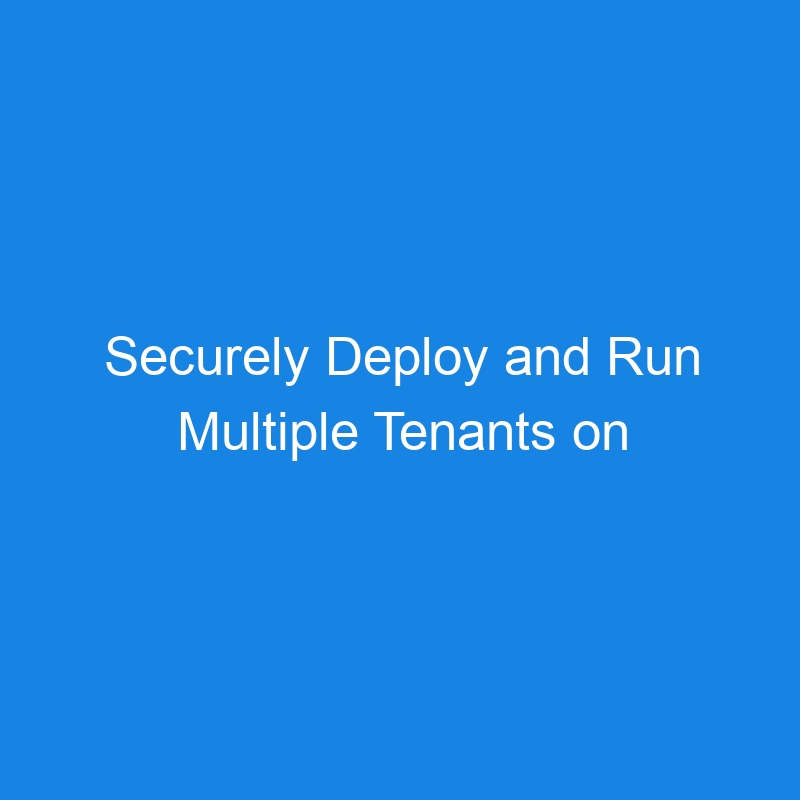
As Kubernetes becomes the backbone of modern cloud native applications, organizations increasingly seek to consolidate workloads and resources by running multiple tenants within the same Kubernetes infrastructure. These tenants could be:
- Internal teams: Departments within a company that share a Kubernetes cluster for development and production.
- External clients: SaaS providers hosting customer workloads on shared infrastructure.
While multitenancy offers cost efficiency and centralized management, it also introduces security and operational challenges:
- How do you ensure strong isolation between tenants?
- How do you manage resources and prevent one tenant from affecting another?
- How do you meet regulatory and compliance requirements?
To address these concerns, practitioners have three primary options for deploying multiple tenants securely on Kubernetes.
How to Deploy Multiple Tenants on Kubernetes
Option 1: Namespace-Based Isolation With Network Policies, RBAC and Security Controls
Namespaces are Kubernetes’ built-in mechanism for logical isolation. This approach uses:
- Namespaces: Logical boundaries for separating tenant workloads.
- RBAC (role-based access control): Restricts tenant access to their namespace and resources.
- Network policies: Controls ingress and egress traffic between pods and namespaces.
- Resource quotas: Limits CPU, memory and other resources to prevent noisy neighbors.
Advantages
- Cost-effective: Tenants share the cluster infrastructure.
- Simple to manage: Centralized operations within a single cluster.
Limitations
- Security risk if misconfigurations occur in RBAC or network policies.
Option 2: Cluster-Level Isolation
This approach assigns each tenant a dedicated Kubernetes cluster, ensuring complete physical or virtual isolation. Tools like Rancher, Google Anthos and AWS EKS simplify managing multiple clusters.
Advantages
- Strong isolation: Tenants do not share any cluster components.
- High security: No risk of cross-tenant data leakage or resource contention.
Limitations
- High cost: Each cluster incurs control plane and node costs.
- Operational complexity: Managing, upgrading and monitoring multiple clusters is resource-intensive.
- Scalability challenges: Provisioning new clusters can delay tenant onboarding.
Option 3: Virtual Clusters
Virtual clusters provide tenant-specific control planes within a shared physical cluster. Each tenant gets their virtual Kubernetes environment while sharing the worker nodes and physical infrastructure.
Advantages
- Strong logical isolation: Tenant workloads operate independently.
- Cost-efficiency: Shared worker nodes reduce infrastructure costs.
- Scalability: Virtual clusters can be provisioned quickly, often in seconds.
Limitations
- Higher complexity due to infrastructure-level isolation compared to namespace-based isolation.
- Performance impact if worker nodes are over-committed.
Detailed Comparison Table
| Aspect | Namespace-Based Isolation | Cluster-Level Isolation | Virtual Clusters |
| Isolation Level | Logical isolation using namespaces, RBAC and network policies. Relies on proper configuration. | Physical or virtual isolation; no shared cluster components. | Logical isolation: Each tenant gets a virtual Kubernetes cluster running inside a shared physical cluster. |
| Security | High: Vulnerabilities in shared components (such as API server, etcd) or misconfigured policies can lead to breaches. | Very High: One tenant’s vulnerabilities do not affect others. | High: Virtual clusters provide tenant-specific control planes, reducing risk of cross-tenant issues. |
| Resource Contention | Possible: All tenants share cluster resources like nodes and control plane, leading to potential resource contention. | None: Dedicated resources for each tenant, ensuring no resource interference. | Possible: Shared worker nodes but isolated control planes reduce contention for control-plane-related operations. |
| Scalability | High: Adding new tenants requires creating a new namespace and applying policies within the existing cluster. | Limited: Adding new tenants requires provisioning and managing new clusters. | High: New virtual clusters can be provisioned quickly within the existing physical cluster. |
| Cost | Low: Shared cluster resources reduce infrastructure and operational costs. | High: Separate clusters increase infrastructure, operational and monitoring costs. | Moderate: Shared infrastructure reduces costs compared to physical clusters but higher than namespace isolation. |
| Operational Complexity | Low: Single cluster to manage but requires careful configuration of namespaces, RBAC and network policies. | High: Managing multiple clusters adds significant operational overhead and requires specialized tools. | Moderate: Centralized management simplifies operations compared to physical clusters but still involves managing virtual clusters. |
| Performance Isolation | Moderate: Tenants share control plane and node resources, potentially affecting performance during resource spikes. | High: Performance is isolated due to dedicated clusters. | Moderate: Control planes are isolated; however, shared worker nodes affect performance. |
| Management Overhead | Low: Centralized control over tenants within one cluster. | High: Separate control planes and clusters increase management overhead. | Moderate: Simplified management compared to physical clusters but more overhead than namespaces. |
Can You Just Leave Multitenancy Unaddressed?
Failing to implement a robust multitenancy strategy can lead to:
- Security breaches: Misconfigurations in shared clusters can allow one tenant to access another’s workloads or data.
- Resource contention: A single tenant can monopolize shared resources, degrading performance for others.
- Noncompliance: Inadequate isolation can result in failure to meet regulatory requirements like HIPAA or PCI-DSS.
- Operational inefficiency: Poorly designed multitenancy increases management overhead and risks cluster downtime.
Secure multitenancy in Kubernetes is crucial for maintaining the security posture of Kubernetes clusters for compliance and security requirements. Multitenancy consolidates workloads and resources efficiently and saves money with centralized management, but it introduces significant security and operational challenges that must be addressed through best practices such as namespace-based isolation or secure deployment of virtual clusters. Because failing to properly secure multitenancy can lead to compliance violations and security gaps, implementing robust security measures and isolation techniques is essential for maintaining a secure and efficient multitenant environment in Kubernetes.
The post Securely Deploy and Run Multiple Tenants on Kubernetes appeared first on The New Stack.
